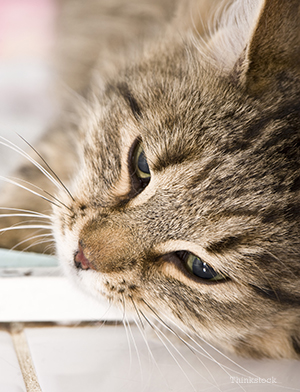If you’ve had a cat for more than a month, you’ve surely experienced the delight of feline vomit in an inconvenient location.
Most cat guardians and many veterinarians probably consider regular vomiting of food, bile or hairballs “normal” for a cat. Yet, recent research challenges these long-held assumptions, and warns us to take vomiting seriously.

Studying vomiting in cats
For this study, conducted by the Alamo Feline Health Center and published in the Journal of the American Veterinary Medical Association, researchers performed an ultrasound on cats who presented with vomiting, diarrhea and/or weight loss.
It’s important to note that endoscopy (placing a camera into the intestine) would have been another method for the researchers to take biopsies. However, this option, even though it is less invasive than surgery, does not give results that are as good. In addition, only surgery allows for biopsies of the entire thickness of the intestine, whereas endoscopy only allows biopsies of the superficial layers.
Here are the results of the biopsies, which were read under the microscope by a pathologist:
- One cat had no abnormal findings1.
- Forty-nine cats had a condition generically called chronic enteritis, which means long-term inflammation or irritation of the small intestine. (One of the diseases that belongs to that group is Inflammatory Bowel Disease [IBD, similar to IBS in people]). Those cats were aged from one to sixteen years, with an average age of ten1.
- Forty-six cats had lymphoma of the small intestine, a type of cancer. Those cats were aged from one to eighteen years, with a mean age of twelve1. Four cats had other types of cancer: three had mast cell tumors and one had adenocarcinoma1.
- Even though the age ranges look similar, there was a statistical difference between the two groups: cats with chronic enteritis tended to be younger (under eight years of age), and cats over eight years of age tended to have either enteritis or intestinal cancer.
What has this study taught us about vomiting in cats?
There are several lessons we can learn from this important study:
- Take every opportunity to weigh your cat with your veterinarian. Weight loss was the most common sign of disease, present in 70% of the cats, sometimes without vomiting or diarrhea1.
- An ultrasound, which is non-invasive, should be used to measure the thickness of the small intestine of cats presenting with vomiting, diarrhea and/or weight loss. If the bowel is abnormal, surgical biopsies should be taken and sent to the lab for analysis.
- Old age should not be a reason to decline anesthesia and surgery. This will delay treatment. None of the cats in the study died as a result of surgery.
- Vomiting more than twice a month is a reason to go to your family veterinarian, and it should always be investigated.
Questions to ask your veterinarian:
- If your cat vomits more often than twice a month, ask your veterinarian what can be done--not just to prevent vomiting, but to find a cause.
- Once a cause has been determined, ask how your cat can best be treated.
- Ask, what is the likely outcome of your cat's condition?
If you have any questions or concerns, you should always visit or call your veterinarian -- they are your best resource to ensure the health and well-being of your pets.
Resources
